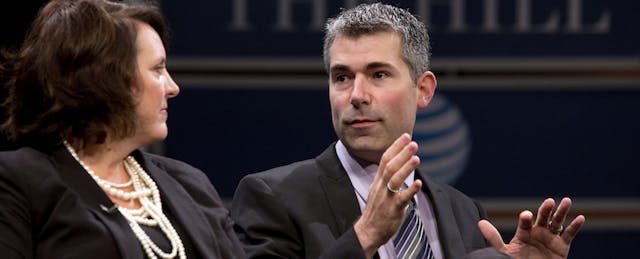Editor’s Note: ‘Tis the trendy season for trends, to reflect on 2015 and to make bold predictions about what next year may hold. This year, we asked thought leaders to share their outlooks on education, but with a twist. They have to frame their thoughts as a response to some of the finest college application essay prompts—yes, the very same ones that high school seniors are feverishly working on now!
Here's what Richard Culatta, outgoing Director of the US Office of Education Technology, had to say.
Writing prompt: A neon installation by the artist Jeppe Hein in UChicago’s Charles M. Harper Center asks this question for us: “Why are you here and not somewhere else?” Why are you “here” (doing what you’re doing) and not somewhere else? (University of Chicago)
Many years ago I served as the Director of Operations for a group of schools in the mountains of Guatemala. The schools were created to provide educational opportunities for impoverished children who had been consistently and systematically deprived access to quality education. We did everything we could think of to prepare these kids to break a generational cycle of poverty; built classrooms, recruited teachers, and collected books for a library.
But the gap between what those students needed to succeed and what we could provide them seemed hopelessly wide. Everything we were doing felt too little and too late. How could we ever expect to give poor kids on a rural mountainside the same shot at success as their wealthy peers in the city or around the world?
One day I proposed a crazy idea (remember this was nearly 15 years ago): what if we connected these schools to the internet? That idea launched a process of learning and scheming that eventually led to a plan: Through a series of generous donations, trial and error, and a large amount to duct tape, we were able to create a satellite internet connection at one of the schools.
There are probably still pictures on the interwebs of me hanging from phone lines, in violation of at least a dozen city ordinances, stringing CAT5 cable from the satellite dish over to our classrooms. Connecting these remote schools to the Internet didn’t immediately solve generations of inequity. But the moment we plugged in that cable, a hundred students who were always last in line suddenly had the same access to the tools, materials, and expertise as their most privileged counterparts around the world. That was when I really began to understand the power of technology as a tool to level the playing field.
I’ve spent a little over four years at the Department of Education because there are still far too many equity gaps right here in our own country. I believe that technology, when implemented effectively, is one of the most powerful tools we have for closing those gaps. This theme is central to the recently released National Ed Tech Plan and all of the recent work of the Office of Educational Technology. It’s the reason we invested so heavily in making sure all schools have access to high-speed wireless in their classrooms, and the reason we focused relentlessly on supporting school leaders in rethinking their vision the future of their schools.
There are some interesting things I’ve learned along the way.
First of all, government can be an incredible force for good when it engages in partnerships with the field. Initiatives like ConnectED, Future Ready, GoOpen, Datapalooza, and Education Innovation Clusters, were all possible through collaborations with non-profit organizations, educational institutions, and the private sector.
Second, we can attract amazingly talented people to government if we ask them to help solve specific problems. In my time at ED I helped launch an innovation fellowship where top education leaders and tech developers from the most prestigious organizations could spend two years working side-by-side career government staff to tackle really thorny problems (like connecting 70,000 schools to internet or making college affordable for everyone).
And third, there is power in sharing stories of the great things that are already happening in our schools and communities. Creative leaders have found solutions to just about every challenging educational problem—but nowhere near enough people know about them. This was the reason for creating the Story Engine Tool and the Future Ready Leadership Videos.
So what’s next? As I transition to a new chapter, I’m excited to focus on approaches for accelerating innovation and making government more effective and efficient. I believe that government, when designed around the needs of citizens, can be transformational. I’m excited to spend a few weeks learning more about the power of human-centered design at IDEO with Sandy Speicher’s Design for Learning team before returning to my home state of Rhode Island (one of the most exciting places for innovation in the country).
It has been an honor to serve alongside dedicated teachers, leaders, policy makers, parents and students who work tirelessly on behalf of learners of all ages. I’ve been inspired by working for a Secretary of Education who cares so deeply about making sure the needs of all students are addressed. And I’ve been propelled by colleagues who are intolerant of the status quo when it’s not good enough. There has never been a more exciting time to create the future of learning through technology and never have the tools been so readily available to close persistent equity gaps.


